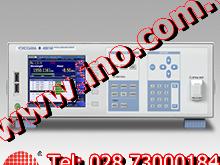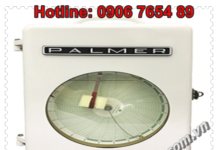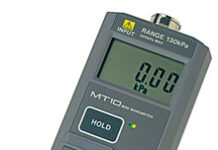The AQ6150 Series Optical Wavelength Meter is an ideal instrument for accurately measuring the optical wavelength of optical devices and systems used in telecommunication applications from 1270 to 1650 nm (including C&L Band). By employing a Michelson interferometer and a high speed Fast Fourier Transform (FFT) algorithm, the AQ6150 series can measure not only a single wavelength laser signal, but also a multiple wavelength laser signal from a DWDM system and Fabry-Perot laser. Furthermore, this technology enables the measurement of modulated laser signals in addition to the CW signal from an optical transceiver.
High wavelength accuracy of ±0.3pm
The real-time correction feature utilizes a highly stable reference signal from the built-in wavelength reference light source in order to provide long-term stability for each measurement taken.
The high accuracy AQ6151 model offers an accuracy of ±0.3pm to meet the most demanding precision requirements.
The standard accuracy AQ6150 offers a ±1pm accuracy for applications with less demanding requirements at a more affordable price.

Cope with modulated light and optical filter measurement
The optical output of optical transceivers and optical transmission systems is modulated with a transmission frequency like 10G and 40Gbps. The built-in Optical Spectrum Analysis capability utilizing an FFT technique is required to measure the spectrum broadened by the modulated signal.
In addition to the regular CW light mode, the AQ6150 Series has a modulated light mode. The modulated mode analyzes the optical spectrum and returns the center wavelength of the modulated light from the transceiver. This mode can also be used for the center wavelength measurement of optical filters such as a band pass filter, AWG and WSS.
Simultaneous measurement of up to 1024 wavelengths
Measure up to 1024 wavelengths in a single input signal with a minimum separation of 5GHz simultaneously, quickly, and accurately. This means the AQ6150 Series optical wavelength meters can meet testing needs in the development and production of WDM transmission system today, as well as in the future.
The multi-wavelength measurement capability contributes to production efficiency and cost reduction in the production of single wavelength laser devices as well by combining multiple laser modules or optical transceivers using an optical coupler and measuring all the signals at once.
Maintain high performance even with low-power input
Equipped with an Auto Gain Control (AGC) function, the AQ6150 Series adjusts the gain of the electrical amplifier automatically based on the input signal power. This helps maximize wavelength accuracy and measurement speed, even if the input signal power is as low as -40 dBm.
Increase throughput with high speed measurement

For the adjustment and characterization of tunable laser sources and tunable optical transceivers requiring hundreds of wavelength measurements per device, high-speed measurement and processing capability are crucial for improving the production throughput. Both models can acquire, analyze, and transfer a measurement to a PC within 0.3 seconds. This is 5 times faster than our conventional model, vastly improving production throughput. In the Repeat Measurement mode, the AQ6150 series can collect 5 measurements per second, making it extremely useful when adjusting a device while monitoring the wavelength in real time.
User-friendly interface
| Easy to view bright color LCD |
|
 |
| USB ports |
|
 |
| Direct operation with mouse |
|
 |
| Data access through LAN | The standard LAN port allows convenient access to files stored in the internal memory as well as the ability to remotely update the firmware from a PC. |  |
Reduce the lifetime ownership cost

With the conventional wavelength meter, the high failure rate of the wavelength reference light source and its high replacement costs have been a major contribution to the overall ownership costs over a product life.
One of the key product design goals was to address these issues. This was achieved by a multi-dimensional approach, giving the AQ6150 Series the ability to extend the service life of the light source and by reduce the overall replacement cost of the unit.













![[AECO- Fiber Optic Sensors- Cảm biến vị trí sợi quang- Những tính năng ưu việt]](https://www.aoip.com.vn/wp-content/uploads/12-100x70.png)







Comments are closed.